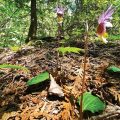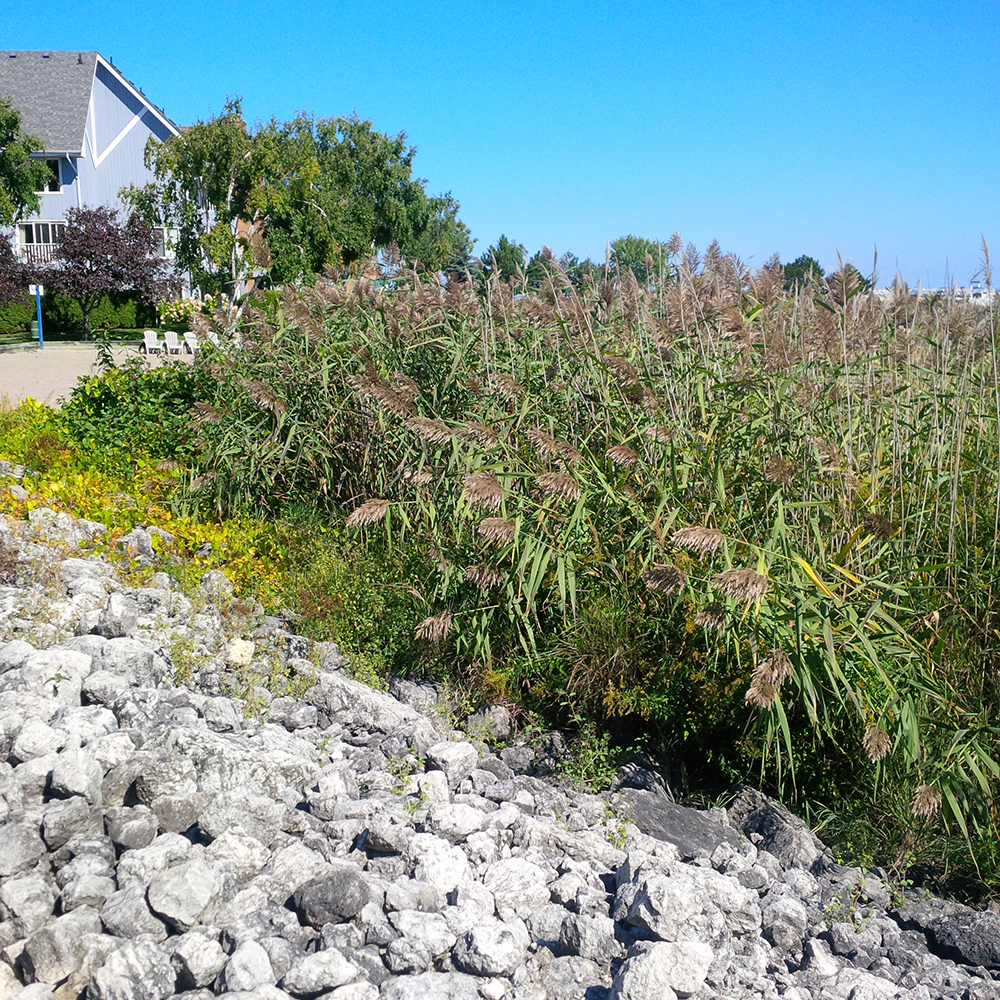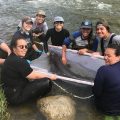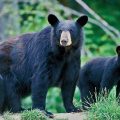The Bruce-Grey region has North America’s largest concentration of wild orchid species outside of Florida. This is the story of one couple’s wild two-year hunt to find and photograph all 49.
by Willy Waterton //. Photography by Willy Waterton
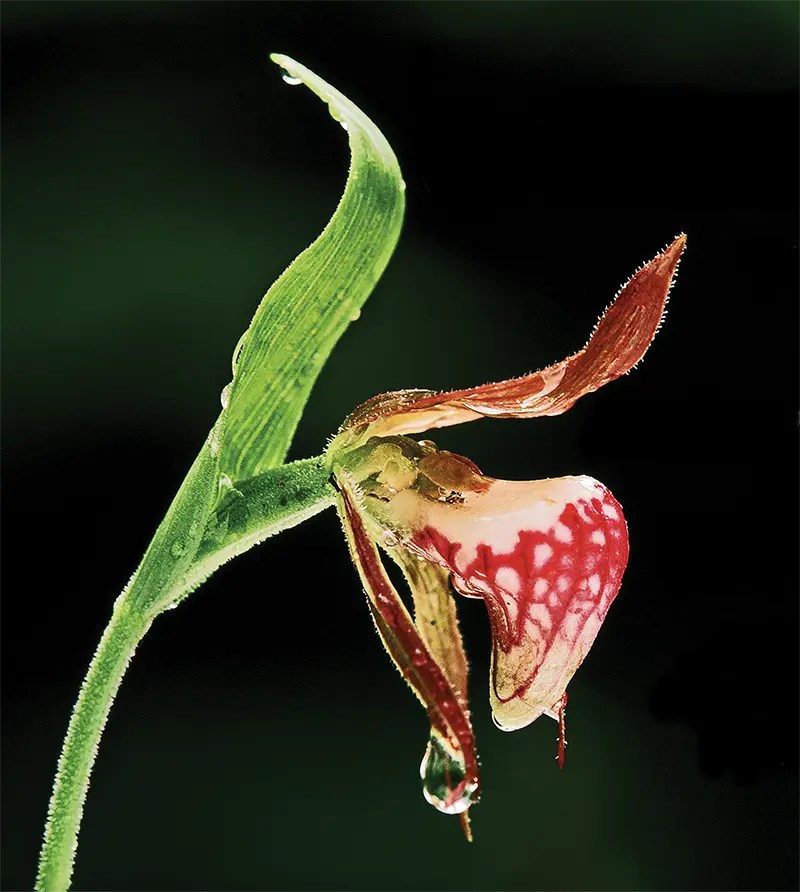
Who knew orchids could be dangerous? Here I was deep in a white cedar swamp tangle with blood dripping down my arm. We were on year one of a two-year quest to find and photograph the 49 native species of orchids found in Bruce-Grey. When the Owen Sound Field Naturalists (OSFN) decided to reprint the Canadian-bestselling Orchids Bruce & Grey field guide, my wife Audrey Armstrong and I volunteered to reshoot the 50- to 60-year-old analog photos with new digital flower identification images for the guide.
At one time I had dreamt of doing a Big Birding Year (the feat, described in numerous books and movies, of trying to identify as many bird species as possible in a single year). However I soon realized I didn’t have the necessary birding skills and redirected my efforts toward the area’s native orchids.
The Bruce-Grey region is blessed with the largest concentration of wild orchid species in North America outside of Florida. Canada has 74 species, Ontario has 63 and in Bruce and Grey we have 49. With COVID travel restrictions in force and the OSFN reprint planned, the time was right. However, although orchids are firmly attached to the ground (unlike flighty birds), the rarer orchids are extremely hard to locate and we knew we would need expert help. Because orchids have been dug up and sold to collectors, not to mention trampled by over-zealous photographers, locations of the rarest species are closely guarded secrets.
Luckily, with our long history of working with the various individuals and organizations who knew the specific orchid locations, we were trusted to ethically photograph them, without disturbing the orchids or their habitat, and to keep the locations top secret.
Hence, my punctured arm as we searched unsuccessfully for the club-spur orchid (Platanthera clavellata) in one of the secret locations. After five visits over two years, we finally did find and photograph the club-spur, but this was just one of many orchid-inspired adventures.


Each blossom has a jasmine-like fragrance that intensifies as night falls, attracting their hawk moth pollinators.
Snakes and bears and worse
The Bruce is known for its resident eastern Massasauga rattlesnakes and black bears. We have had both bear and snake encounters in the past and treasure these symbols of wilderness in southern Ontario. However, we were keenly aware of possible threats and took necessary precautions. Many orchids are tiny, so this requires spending a lot of time lying down on the ground to photograph them—which to a bear may look like a dead or injured animal perfect for dinner! Audrey always accompanied me, (often sketching the orchids as I photographed) and we also always packed bear spray and bear bangers. And though we saw lots of bear scat and flipped-over rocks (bears flip rocks looking for insects) during the orchid quest, we thankfully didn’t meet any bears face to face.
As for Massasauga rattlesnakes: while paddling the Saugeen Bruce Peninsula’s remote wild west coast searching a particular location for a rare orchid, we landed and as Audrey started walking to the cedar bush she was greeted by a buzzing rattlesnake warning us to back off. Despite its name, the Massasauga rattlesnake doesn’t actually sound like a rattle, it sounds more like a bee buzzing, which is why the local nickname on the Bruce for them is “buzz worms.” I had either stepped over or passed very close to the snake without setting it off. We gave the snake a wide berth on our return to the canoe. Normally we wear high boots in snake country but with the hot weather we were paddling in water sandals.
Bears and snakes aside, the biggest threat of all actually came from a tiny new resident to this part of Ontario—ticks! Audrey ended up requiring the full antibiotic treatment for possible Lyme disease after we found a fully engorged blacklegged tick attached to her shoulder. After that, we religiously tucked pants into socks and sprayed insect repellent on our pant legs. Audrey also began wearing gardening gloves pulled up over her shirt cuffs.
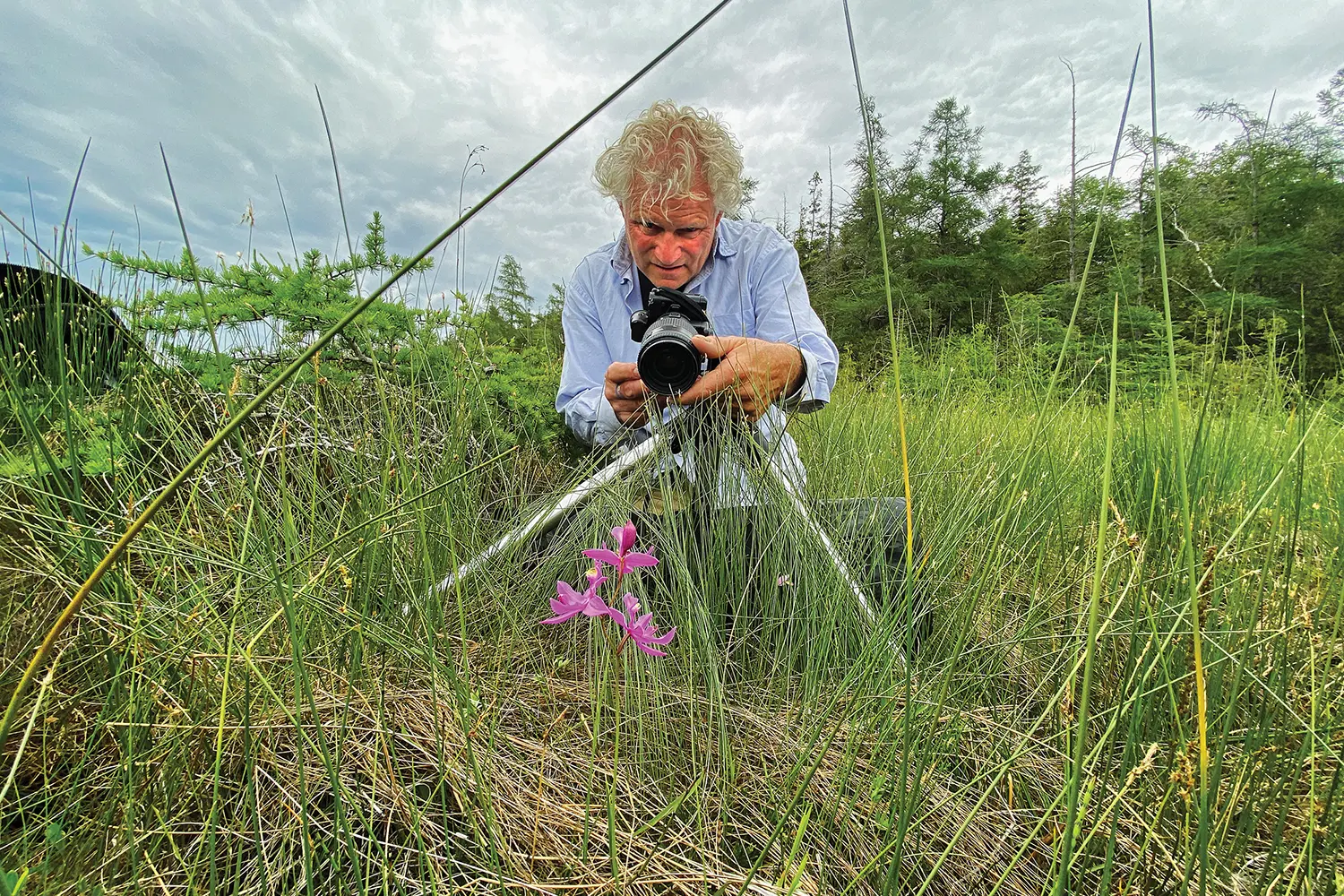
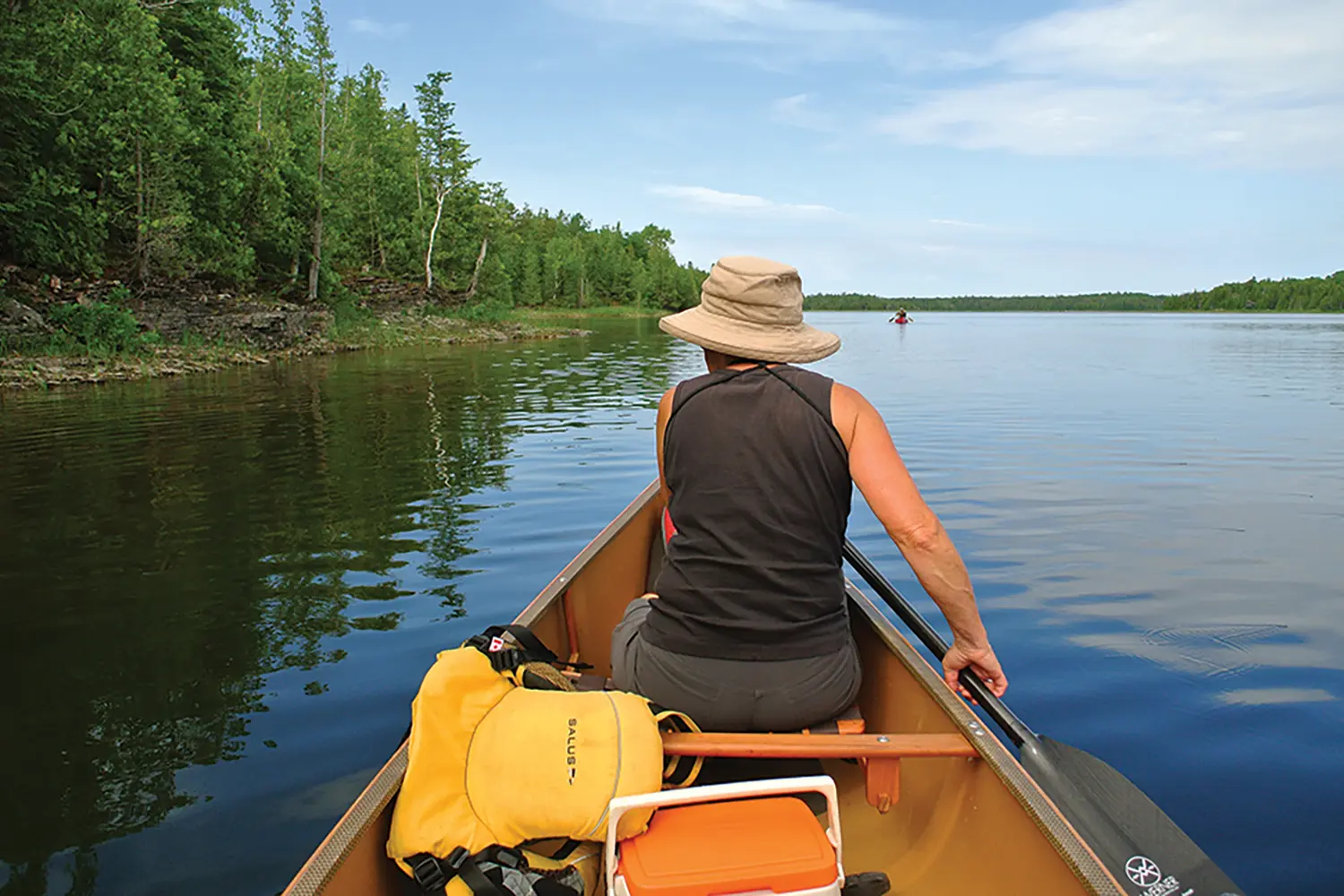
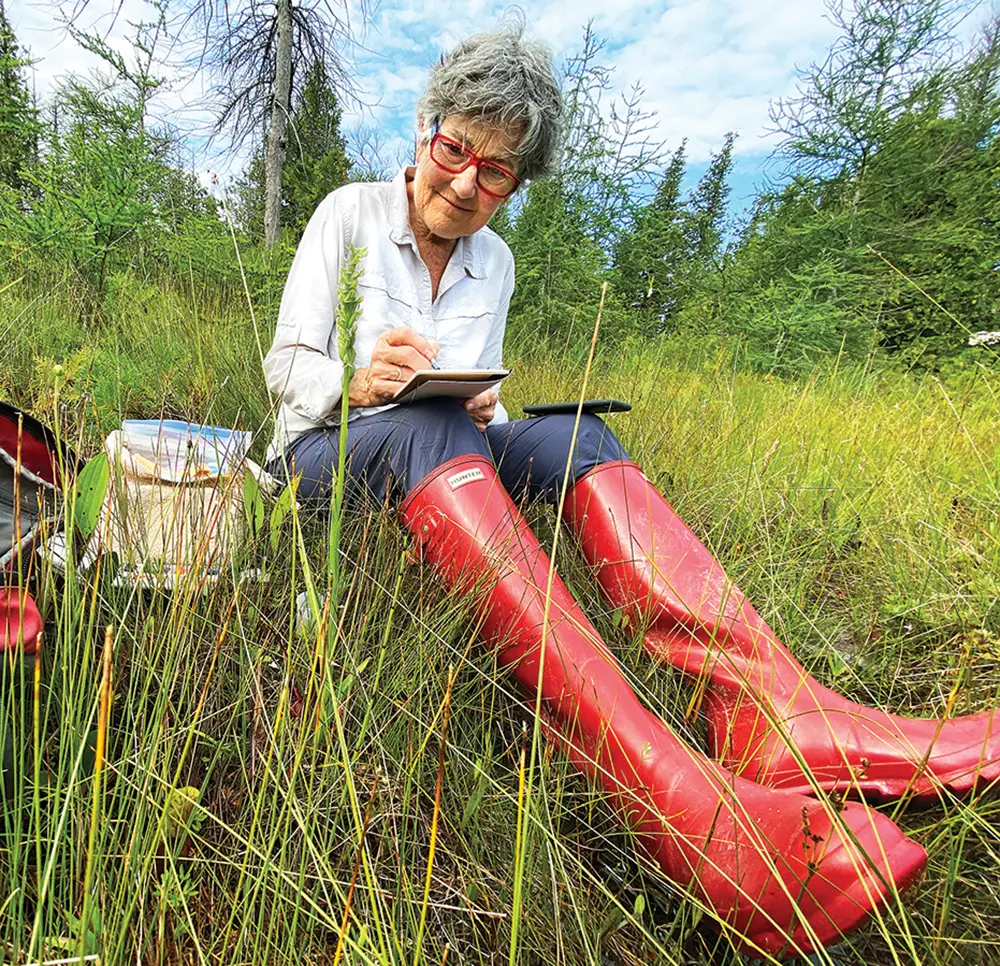

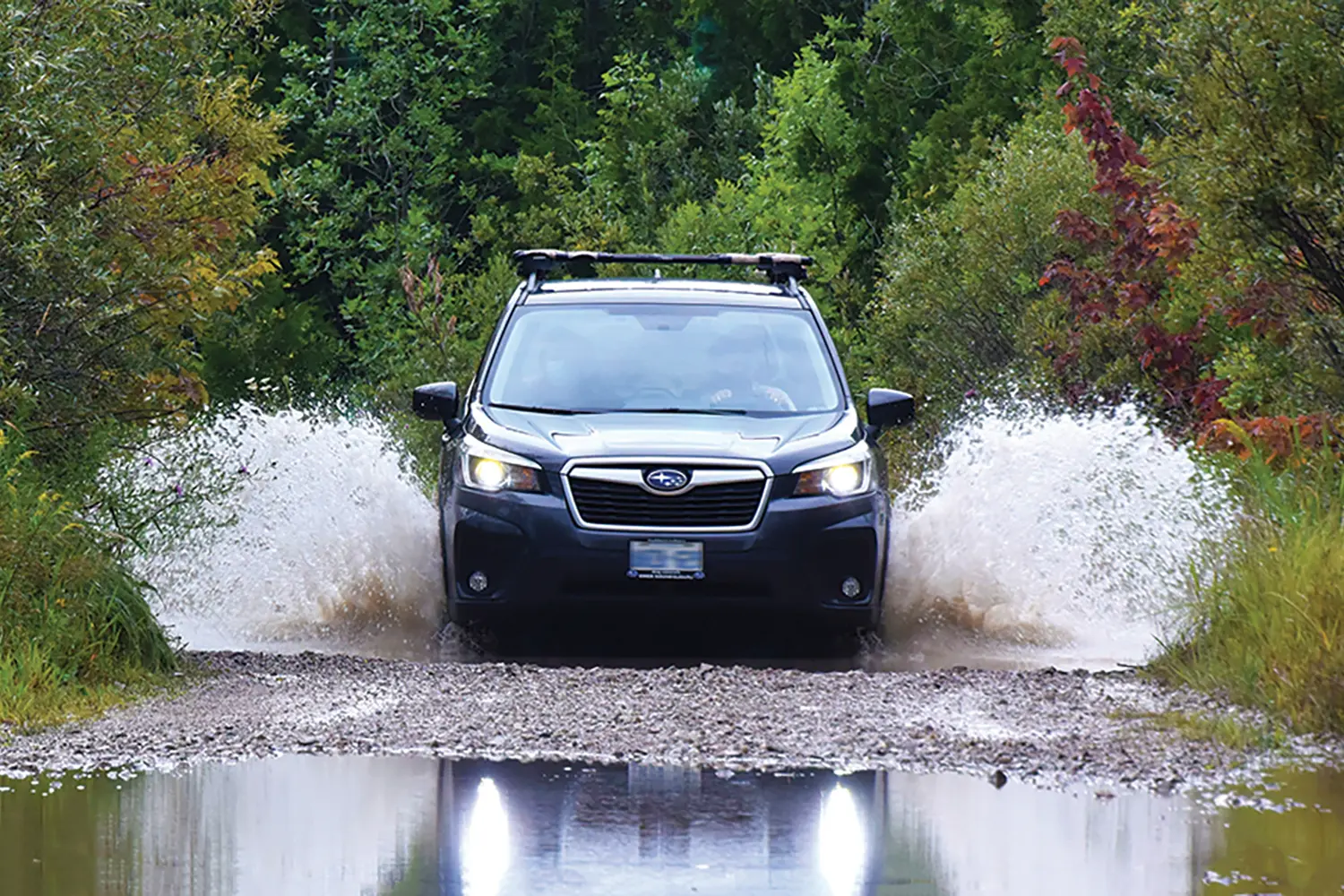
TOP Willy Waterton. LEFT Audrey Armstrong sketching (see sketches below), and on the hunt for the eastern prairie fringed orchid by canoe. ABOVE The calypso orchid and Flooded roads.

Some in plain sight, others deeply hidden
While driving to Tobermory along Highway 6, you might think the yellow flowers blanketing the ditches from mid-May to early July are dandelions. Slow down or pull over for a close look and you’ll find not only dandelions but Bruce’s most abundant orchid, the large yellow lady’s slipper (Cypripedium parviflorum var. pubescens). It features a spectacular golden balloon-like blossom which is a sunny reminder of the orchid season in our area.
Just as beautiful but rarer is the pink lady’s slipper or pink moccasin flower orchid (Cypripedium acaule). Artist Tom Thomson painted this flower around 1915 in Algonquin Park. I wonder if he saw this orchid in swamps when he was growing up in the Leith area northeast of Owen Sound.
We also have the very rare, globally, nationally and provincially endangered orchid, the eastern prairie fringed orchid (Platanthera leucophaea), well-protected by its inaccessibility—requiring access over very rough former logging roads through locked and gated private lands and finally a long paddle to access lakes deep within the Bruce Peninsula National Park. Here you find one of the largest populations of these orchids in eastern North America.
Each blossom has a jasmine-like fragrance that intensifies as night falls, attracting their hawk moth pollinators. Photographing such a rare plant, as the fragrance filled the air, made me realize what an incredible place this is and how important it is to protect habitat and educate the public about the Saugeen Bruce Peninsula’s delicate environment.
If orchids are so rare, you may wonder how you will ever be able to see them. Well, it turns out we actually found 11 of our orchid species flowering in roadside ditches, such as the small purple fringed orchid (Platanthera psycodes). At first glance you might think it’s a purple hyacinth. This spectacular magenta spired orchid was well worth the thigh-deep soaking I received to reach the far side of the water-filled ditch in northern Grey County.


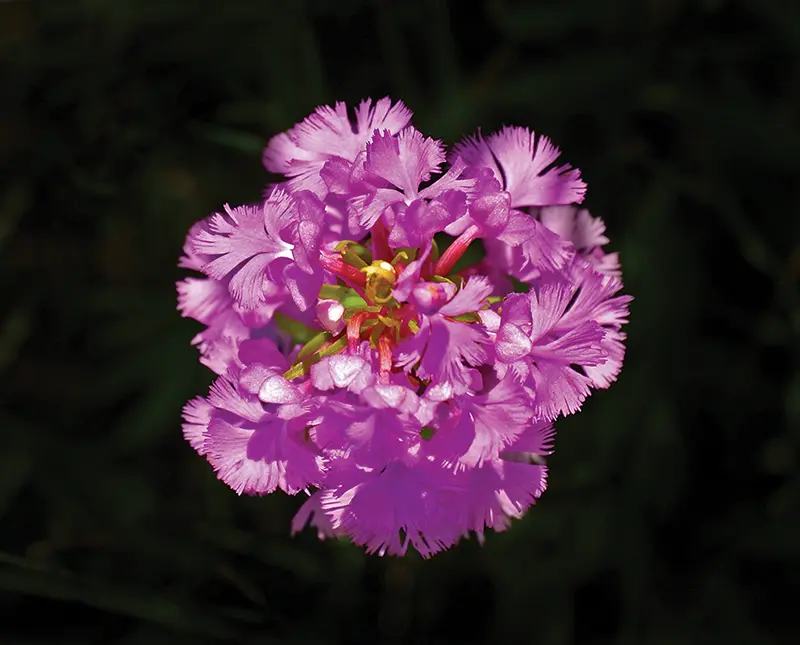
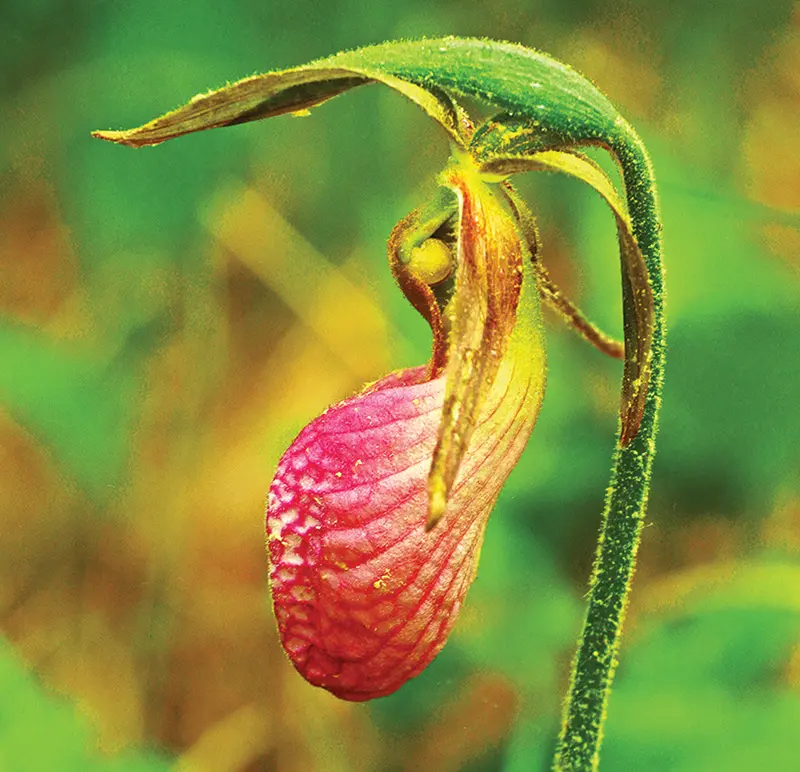

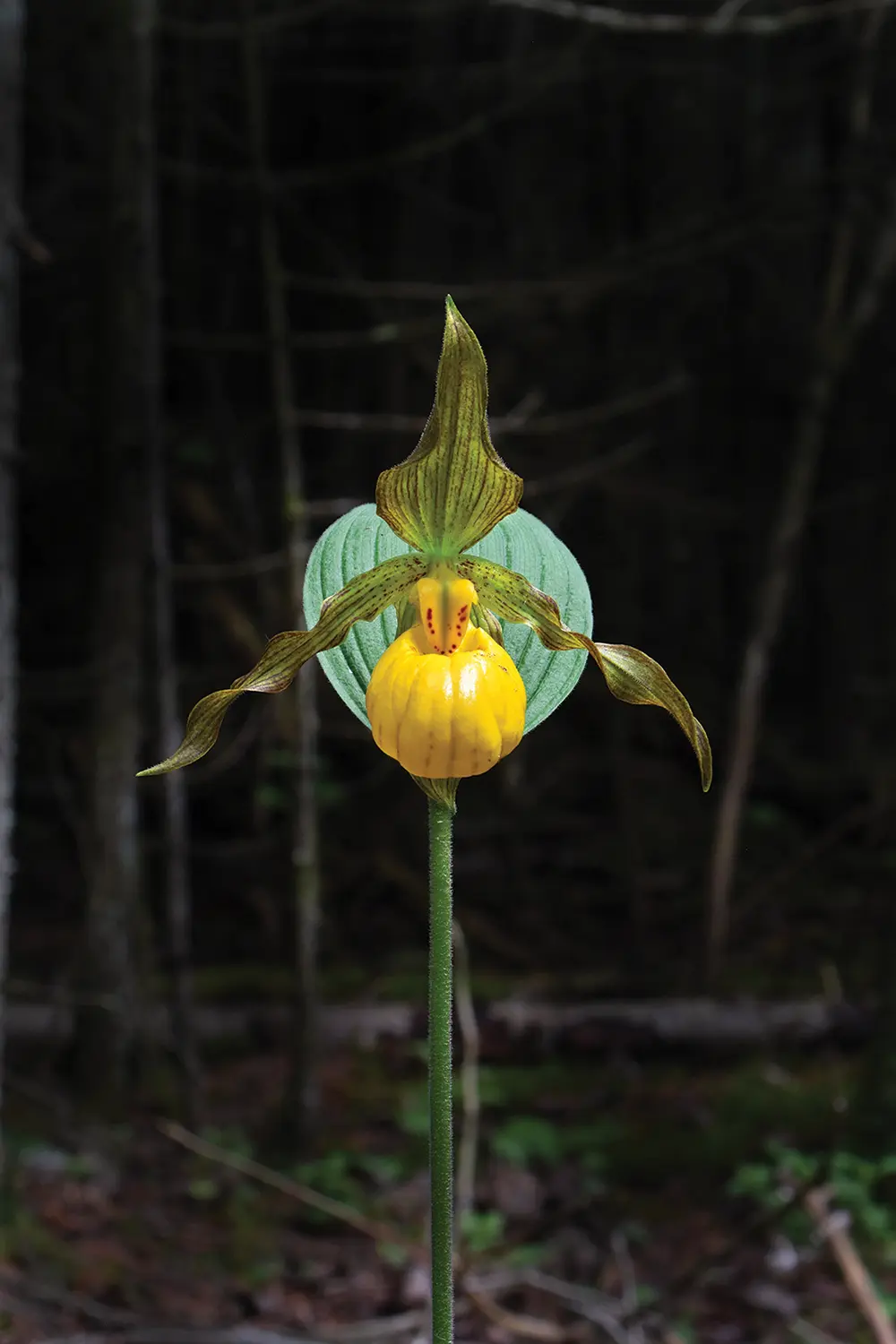

CLOCKWISE FROM TOP LEFT Rose pogonia, small purple fringed orchid, large yellow lady’s slipper, dwarf rattlesnake plantain, Pringle’s coralroot, small purple fringed orchid. CENTRE Pink lady’s slipper.
Just as beautiful but rarer is the pink lady’s slipper or pink moccasin flower orchid (Cypripedium acaule). Artist Tom Thomson painted this flower around 1915 in Algonquin Park.
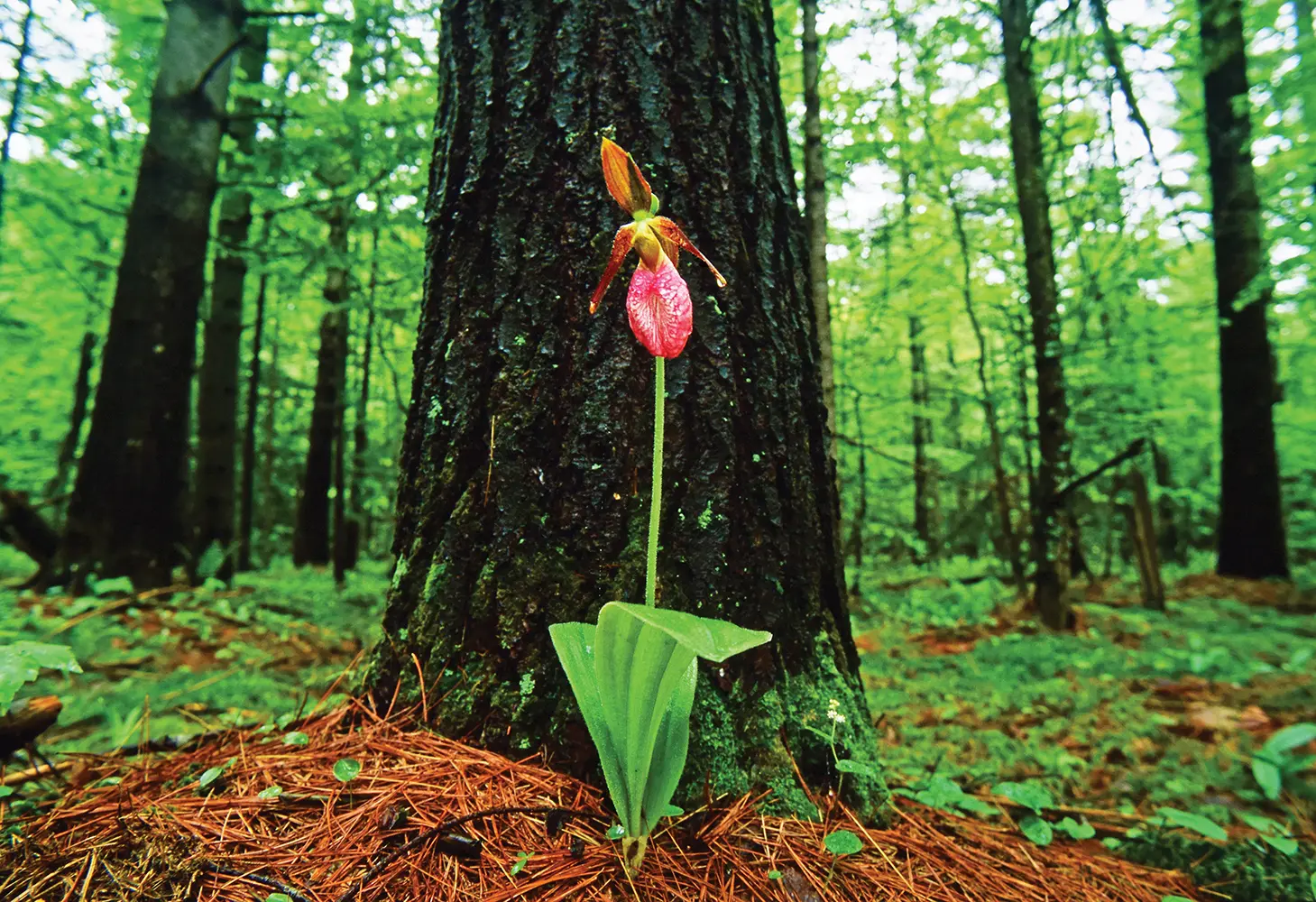
A thorough soaking is part of the adventure
Without help from knowledgeable individuals we wouldn’t have found many of the rarer orchids. Having kept impeccable notes, photos, and hand-drawn maps, one of our expert partners was able to lead us into a 8,094-hectare Bruce County swamp to the northern tubercled orchid (Platanthera flava). We found only one plant after spending several hours searching for more specimens. It had been 10 years since this partner had been to the plant site! We had tried earlier in the summer to find the orchid on our own. We were close, but were unable to penetrate the swamp because of unprecedented summer rains that had flooded the swamp waist deep. Not to mention hordes of hungry mosquitos. We waded in but gave up after water reached above our rubber boots.
On another trip up the Saugeen Bruce Peninsula, we had to navigate roads flooded by beavers to reach the site of the beautiful downy rattlesnake plantain (Goodyera pubescens).
Venturing into bogs, we occasionally plunged thigh-deep through the floating rafts of vegetation. It brought back memories of Nels Maher (an Owen Sound fern and orchid expert) who had told us that, many years ago, he used snowshoes to spread his weight as he negotiated these floating bogs. The image has never left my mind of Maher (likely puffing on his tobacco pipe), trudging across the bogs of Bruce and Grey in the heat of summer on old-style snowshoes!
“I never before saw a plant so full of life; so perfectly spiritual, it seemed pure enough for the throne of its Creator.”
JOHN MUIR

In the footsteps of John Muir
One of the more intriguing stories associated with our local orchids involves the great American conservationist John Muir, who along with his younger brother Dan, spent two very impressionable years in what we now call Ontario. It was 1863 and the American Civil war was raging. Muir’s mother, Ann Gilrye, was afraid her sons would soon be drafted into the army. The Muirs had immigrated from Scotland a decade before and didn’t believe the Civil War was their fight. She encouraged the boys to travel to Canada. Dan arrived in Ontario first; John followed in 1864.
The Muir brothers explored southern Ontario, finally winding up working for the Trout family at their rake and broom-handle factory in Trout Hollow on the Bighead River near Meaford. During his time off, John botanized locally and made longer rambles farther afield.
Muir wrote, “I never before saw a plant so full of life; so perfectly spiritual, it seemed pure enough for the throne of its Creator. I felt as if I were in the presence of superior beings who loved me and beckoned me to come, I sat down beside them and wept for joy. Could angels in their better land show us a more beautiful plant?” Having spent two years chasing these “beautiful plants,” I totally understand Muir’s feelings.
The bloody puncture wound didn’t require stitches and now I have a small scar to remind me of our remarkable adventures photographing Bruce-Grey’s wild orchids.
The Owen Sound Field Naturalists’ book, Orchids Bruce & Grey ($30) is available online at osfn.ca.
Orchid Facts
One of the oldest families of flowering plants, orchid varieties are found all over the world except on Antarctica. Experts believe they have been around since before the continents separated.
- Orchids are the largest family of flowering plants. With estimates of 28,000 species worldwide, there are more orchids on the planet than mammals and birds.
- Orchids can thrive from sea level to 5,000 metres elevation.
- Bruce and Grey counties have 49 orchid species which is 70 percent of the species found in Ontario and the largest concentration of orchids anywhere in North America apart from Florida.
- In Bruce and Grey, seven orchid species and one variety are nationally and provincially rare.
- Orchids have the tiniest seeds in the world. A single seed pod can contain up to three million microscopic seeds.
- Orchids have a partnership with fungi, without which they would not survive. This is why you must not dig them up in the wild; they won’t grow in your backyard! Fungi roots break open orchid seeds to help them germinate and provide nutrients as they mature.
- Orchid flowers are bilaterally symmetrical. Each flower can be divided perfectly in half, with two equal parts.
- The vanilla bean comes from a species of orchid, Vanilla planifolia, which is the only commercially grown and harvested orchid plant.
- A feature that distinguishes orchids from other flowers is that the stamens are fused with the pistil to form the column, which is the reproductive centre of all orchid blossoms.
Sources: Orchids Bruce & Grey and englishgardens.com/fun-facts-about-orchids.






